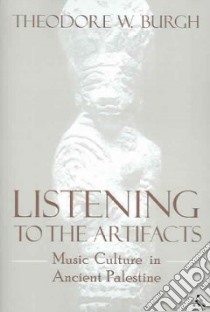Listening to the Artifacts - 9780567025524
Un libro in lingua di Burgh Theodore W. edito da Continuum Intl Pub Group, 2006
- € 33.40
- Il prezzo è variabile in funzione del cambio della valuta d’origine
Music is an essential component of all cultures. It conveys instruction, expresses emotion, and is used for teaching and recreational purposes. Without a doubt, music functioned in these capacities in ancient Israel. Although scholars rarely discuss the role of music in Israel's history and culture, recent studies have demonstrated that understanding Israel's music greatly contributes to our knowledge of the culture of ancient Israel/Palestine. Do You Hear What I Hear? examines the use of music and musical instruments in the ancient Israel and Palestine. By taking a close look at some of the enigmatic and under-researched subjects of ancient music, Burgh discusses ways in which the study of music can help us understand daily life in ancient Israel better. Presently, the available collection of musical artifacts from Israel/Palestine dates from 10,000 BCE-4th century CE and numbers over 300 items. While focusing on Iron Age Israel/Palestine (1200-586 BCE), Do You Hear What I Hear? uses many of these artifacts, which come from various regions, and draws on examples from surrounding Near Eastern cultures. Burgh uses plaque figurines, figurines in the round, and instrumental remains as well as line drawings of musical activity found on ceramic vessels and walls of buildings to examine music in the ancient Near East. Burgh takes the available musical data and explores how, where, and why music played a part in the lives of those living in ancient Israel/Palestine. His book clearly demonstrates that for the people of this region and time music was an organic, evolving mode of communication that often reflected how they understood life and navigated the world around them. Do You Hear What I Hear? suggests that we listen closely and unassumingly to the artifacts and texts in order to hear what they may tell us about past lifeways. >
Informazioni bibliografiche
- Titolo del Libro in lingua: Listening to the Artifacts
- Sottotitolo: Music Culture in Ancient Palestine
- Lingua: English
- Autore: Burgh Theodore W.
- Editore: Continuum Intl Pub Group
- Collana: Continuum Intl Pub Group (Paperback)
- Data di Pubblicazione: 01 Gennaio '06
- Genere: RELIGION
- Argomenti : Music Middle East To 500 History and criticism Musical instruments, Ancient Middle East Performance practice (Music) Middle East
- Pagine: 181
- Dimensioni mm: 228 x 152 x 19
- ISBN-10: 0567025527
- EAN-13: 9780567025524


